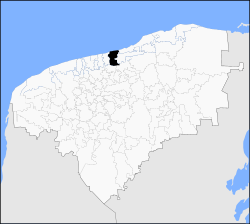Dzidzantún
This article has multiple issues. Please help improve it or discuss these issues on the talk page. (Learn how and when to remove these messages)
|
Dzidzantún | |
|---|---|
Town | |
 Municipal Palace of Dzidzantún | |
 Location of the Town in the State of Yucatán | |
| Country | |
| State | |
| Government | |
| • Mayor | Ismael Aguilar Puc (PRI) |
| Area | |
| • Total | 198 km2 (76 sq mi) |
| [1] | |
| Elevation | 10 m (30 ft) |
| Population | |
| • Total | 8,119 |
| • Density | 41/km2 (110/sq mi) |
| • Demonym | Dzidzantunence |
| town[4] | |
| Time zone | Central Standard Time |
| • Summer (DST) | Central Daylight Time |
| Area code | 991 |
| INEGI Code | 027 |
| Major Airport | Merida (Manuel Crescencio Rejón) International Airport |
| IATA Code | MID |
| ICAO Code | MMMD |
| Website | Official Website |
Dzidzantún is a town in Mexico in the northeastern Yucatan, which serves as the headquarters of the municipio or administrative unit of the Dzidzantún Municipality.
Climate
| Climate data for Dzidzantún | |||||||||||||
|---|---|---|---|---|---|---|---|---|---|---|---|---|---|
| Month | Jan | Feb | Mar | Apr | May | Jun | Jul | Aug | Sep | Oct | Nov | Dec | Year |
| Mean daily maximum °C (°F) | 32.4 (90.3) |
33.7 (92.7) |
34.7 (94.5) |
35.3 (95.5) |
36.2 (97.2) |
35.8 (96.4) |
35.8 (96.4) |
35.9 (96.6) |
35.6 (96.1) |
34.8 (94.6) |
33.2 (91.8) |
32.7 (90.9) |
34.7 (94.5) |
| Mean daily minimum °C (°F) | 18.5 (65.3) |
19.5 (67.1) |
20.2 (68.4) |
20.6 (69.1) |
21.5 (70.7) |
21.8 (71.2) |
21.9 (71.4) |
22.1 (71.8) |
21.9 (71.4) |
21.3 (70.3) |
19.9 (67.8) |
18.8 (65.8) |
20.7 (69.3) |
| Average precipitation mm (inches) | 30 (1.2) |
30 (1.2) |
25 (1) |
18 (0.7) |
53 (2.1) |
110 (4.3) |
100 (4) |
110 (4.3) |
130 (5.2) |
110 (4.2) |
41 (1.6) |
43 (1.7) |
800 (31.6) |
| Source: Weatherbase [5] | |||||||||||||
History
Before the Spanish conquest, the site where town of Dzidzantún now stands was located in the lands under the chieftainship of Ah Kin Chel. After the area was conquered by the Spaniards, an encomienda was established in 1549 granting Hernán Muñoz Vaquiano use over the lands in the area in exchange for his taking care of the indigenous people who lived here. Yucatán declared its independence from the Spanish Crown in 1821 and in 1825, the town was assigned to the Temax Municipality. In 1918, Dzidzantún Municipality was created with the town of Dzidzantún as the headquarters of the administration.[1]
Location
This town is located in the coastal region known as the northern Gulf of Mexico. It falls within the parallel 21° 12' and 21° 23' latitude north and between 88° 57' and 89° 04' west longitude and has an average height of 4 meters.[6]
It is bounded on the north by the Gulf of Mexico, south to the cities of Temax and Cansahcab, east to the town of Dzilam Gonzalez and to the west of the town of Yobaín.
Festivals, Dances and Traditions
Popular Festivals
January, festivities in honor of Santa Clara.
June 10 to June 13, will celebrate the festival in honor of San Antonio de Padua, patron of the people.
August 8 to 14 August, festivities in honor of Santa Clara, patron of the people (August 11).
Run the traditional Fiesta, Tradiciones and Customs
For All Saints and faithful departed it is customary to place an altar in the place of the main house, which gives the dead the food that they liked: the traditional Mucbil Pollo, accompanied by corn atole again, and chocolate beaten with water. Regional festivals in the dance jaranas people making skills among participants.
Dress
It is the custom for women to use simple Huipil, highlighting the embroidered square neck and cutting edge clothing, this is placed over the shaft, which is subject to a ripple bottom half at the waist with a girdle of the same fabric; fit sandals and sun protection are covered with a shawl. Farmers, especially the elderly, are dressed in baggy trousers, blanket, raw abotonada front shirt, apron Cotia and straw hat.
For major events and Vaquerías women wear a Terno dress, made of fine fabrics, lace and embroidery generally made by hand in cross stitch. This is supplemented with long gold chains, earrings, coral beads or watermark rebozo and Santa Maria.
The men wear white trousers made of cut straight Philippine fine cloth (the rich have been in the garment buttoning gold), hats and sandals Jipijapa, without missing the traditional red scarf bandana popularly known as essential to the Jarana dance.
Photo gallery
-
Principal Park of Dzidzantún
-
Principal Church of Dzidzantún
-
Dzidzantún Municipal Market
-
Dzidzantún Casa Ejidal
References
- ^ a b "Municipios de Yucatán »Dzidzantún" (in Spanish). Retrieved 4 July 2015.
- ^ "Encyclopedia of the Municipalities of Mexico: Yucatan". Retrieved 2009-11-01.
- ^ Census Results by Locality, 2005 INEGI.
- ^ "http://mexico.pueblosamerica.com/i/dzidzantun/". PueblosAmerica (in Spanish). PueblosAmerica. 2005.
{{cite web}}:|access-date=requires|url=(help); External link in|title=|url=(help) - ^ "Weatherbase: Historical Weather for Dzidzantún, Yucatán". Weatherbase. 2011. Retrieved on November 24, 2011.
- ^ "Latitude/longitude finder". Retrieved 4 July 2015.





